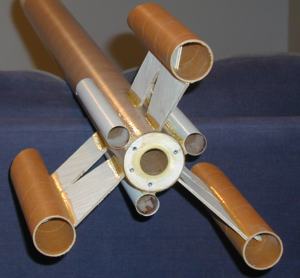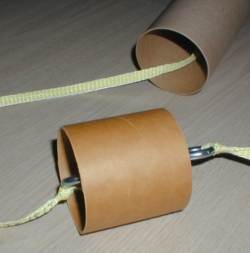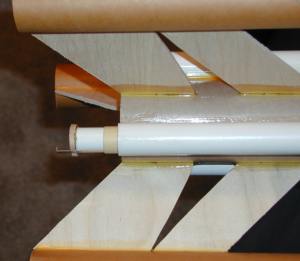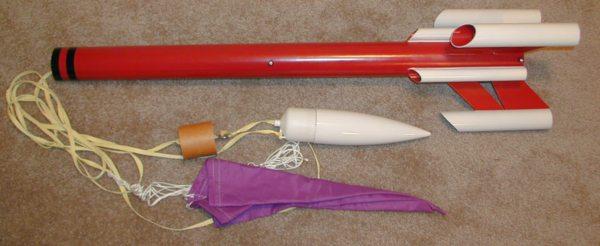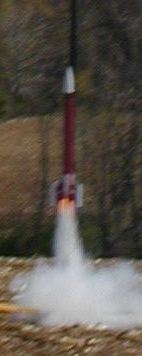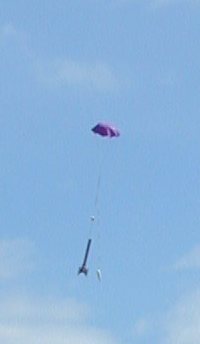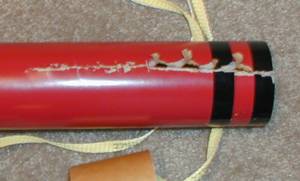| Manufacturer: | Aardvark Rockets |
(04/22/02) I purchased the new SS Triopsis from Aardvark Rockets because of its looks and because it was a cluster rocket kit. I got more than I bargained for. How so? The looks have greatly improved since the original design photos were put up on Aardvark's webpage. Yes, I like the new "design" changes and think it makes the rocket even more futuristic and unique looking.
As far as it being futuristic, read the mission briefing:
Position: Hesteres Quadrant in orbit around the 2nd
M-Class planet in the Molltahr System.
Mission: Routine Science and Security scans for Habitation
Probability.
Commander: ST-7 San'ot Moo'Ini.
Most recent OPLOG Entry: Strangely quiet on board Triopsis. This
paradise seems all to quaint and familiar. This is the 7th M-Class in the last
4 years and the crew is tired. I guess that we all miss Terra Firma a little.
Some of us are missing it more than others. Still, this just seems a little too
good to be true. With the fleet within jump distance, it could make a most
adequate home, provided there are no surprises. Our finest science personnel
aboard are still dumbfounded as to how the bright orange light from the major
sun has been able to fortify such a wondrous vegetative lager on the surface.
We have been able to detect some forms of Nuclear Age peoples but only in VERY
limited areas of the planet. There is absolutely no indication of evidence of
air travel of any kind...including space. It is still against my better
judgement to come here... fuel...food....hope still outweighs that
feeling.
I'm not sure where this is going, however, Aardvark has said that they are putting together a theme-based 2.6" fantasy kit selection called the Thalos line. This was the first of them. (picture courtesy of Aardvark Rockets until mine gets finished)
The Triopsis kit contains:
- (1) 32 1/4" long, 2.6" diameter airframe, which is pre-slotted (sides)
- (3) 10" long, 0.96 (24mm ID) diameter outboard pods that have a 45 degree bevel cut at the top of each
- (3) 10" long, 1.51" (38mm ID) diameter phenolic tubes that are pre-slotted (sides) and also have 45 degree bevel cut in them
- (3) 1/4" birch plywood centering rings, the upper with a hole drilled in it
- (3) 1/4" birch plywood fins
- (1) Plastic Nose Cone
- (1) Eye-bolt hardware set for attaching the shockcord to the upper centering ring
- (3) 18mm motor mounts with thrust ring and centering rings
- (1) 29mm motor tube, 9" in length
- (1) balsa detail stock
- (1) set of water-slide decals
- If the recovery option is purchased with the kit:
- 30" Ripstop Nylon Parachute
- 18' of 3/8" Kevlar® shockcord
CONSTRUCTION:
The instructions are printed on one side of 8x11 sheets of paper and consist of 8 pages including photo, illustrations, kit specs, story, parts checklist and detailed building steps to ensure successful construction. The assemble of this rocket is interesting and the instructions are helpful. I did find a number of mistakes that Aardvark is taking care of. There were several mistakes due to the last minute changes to the rocket's pod configuration. The change was that the outboard pods are now mounted on the side of the airframe rather than being built into the outward fin-pods. To me this is a much better looking design and safer if there is any misfire. However, this change caused a couple of construction problems which will no doubt be resolved by the time this is posted.
Aardvark starts by reminding the builder that we should give some forethought to motor retention and the cluster configuration. Aardvark does not provide any motor retention so that may mean that you need to drill and mount your choice of hardware before you mount your centering rings. Also, for cluster configuration, this rocket could be flown with a central 29mm and (3) 18mm out-boards, or (3) 24mm out-boards or set up to be changeable. The builder must consider this as we get to each appropriate step. As you can see, I placed t-nuts into the bottom centering ring for each 24/18mm out-board motors and one for the 29mm central motor to serve more my motor retention.
The motor tube is built first using the three (3) centering rings and a 9" 29mm motor tube. The upper centering ring has the eye-hook hardware mounted to it to tie the shockcord to. The middle centering ring is positioned to be between the fin slots. All the centering rings fit perfectly on the outside, while the inside only needed the edge rubbed down lightly with sandpaper.
If you purchased the Triopsis with Aardvark's recovery option, you would attach the provided 3/8" Kevlar® to the eye-hook on the upper centering ring. Aardvark provided 18 feet of this Kevlar® line. I decided to make a piston recovery system for my Triopsis and since recovery is an option when purchasing this kit, I don't consider this a modification to the kit. I took two eye-hooks with machine threading and a coupler to hook through a 2.6" bulkhead (originally purchased from Missile Works). I placed it 4 feet up on the recovery line and tied the remaining 12 feet to the top side.
The out-board pods are then attached and are offset from the main body tube by using a 3/8" wide, 1/16" thick piece of balsa cut the same length as the out-board pod. The instructions suggest that this could be shaped to fit perfectly against the out-board pod by wrapping sandpaper around it and rubbing the flat edge against the sandpaper. I didn't do this. After the balsa strip is attached to then the out-boards are attached to the main body. I tried filling my gap with wood glue which made a lot of bubbles. Repeat application was needed to get it to look right. Epoxy may have been better.
The fin attachment was next. The fins are TTWTTW because they attach through-the-wall into the fin-tip tubes and also through-the-wall into the main body to the motor mount. You need to cut away the tubing material from the fin slots. They are pre-cut lengthwise but require you to cut the short widths to complete the task. The fins are unique looking, but are still one piece and therefore alignment is not an issue. This is where I found another issue due to Aardvark's last minute changes to the kit. The fin-tip tubes are now phenolic (that is a great thing due to the expect abuse they will take on landings) and are thicker than cardboard tubes, so the outer fin tab did not reach all the way to the opposite inside wall. I remedied this by simply taking the strip of phenolic material that I cut away when completing the fin slot cuts and glued it onto the end of the fin tab. Perfect!
One of the final steps prior to finishing is deciding what you want to do for the out-board motors. Aardvark provides 3 sets of parts for making 18mm motor mounts. You can assemble them (you may want to add your own motor hook) and glue them into the out-boards. This will then allow you to only use 18mm out-board motors. You can throw away the 18mm tubes, glue in a provided 18-24mm centering ring as a 24mm thrust ring and only use 24mm motors for out-boards. Or, you can get yourself an extra set of 24mm thrust rings, glue them into the out-boards, build up the 18mm mounts and have them as adaptors. I did the latter as pictured here with one of my 18mm adaptors (with a added motor hook) partially sticking into the out-board tube.
As I stated before, there were several mistakes due to the last minute changes to the rocket's pod configuration. I'm highly confident that Aardvark has taken care of this, but just in case you purchased a kit before it was corrected, here are the details:
- In Step #2 and #3 there is a contradiction. Step #2 says to measure the line to 4", step #3 says 7". What I found is that one should mark it 1/2" from bottom of tube, then 4" from bottom of tube. I think step #2 has these measurements from the top.
- In step #6, you use up all the 3/8" flat balsa stock (all except about 4 inches). But in step #7, you are supposed to use some of this stock (or other that did not come) to make the details on the outside of the out-board tubes. My guess is the bag was supposed to have 2 pieces.
- In step #9, the fin tab does not fit all the way through the phenolic tube to the opposite side. I took the pieces of phenolic tube that were cut out from the fin slots and glued them to the end of the fin tabs and then they fit perfectly.
As it is still too cold here in Vermont to paint, I have not been able to finish the Triopsis. The instructions provide a good description for finishing and provides a set of water-slide decals. I'm looking forward to painting this model up and will plan on utilizing different colors to accent the out-board and fin-tip tubes. Stay tuned . . .
Well from the picture below you can see I finished painting it. I added rail buttons (red ones). My finished weight was 29 ounces.
Overall, for CONSTRUCTION I would rate this kit 4 points. I was pleased with the quality of the parts, especially having phenolic for the fin-tip tubes. The beveled cuts add to the overall good looks of the kit. Aardvark's Kevlar® Shock Cord is great. I would have liked to see (3) 24mm thrust rings tossed into the kit just to allow that third option (the one I took) without having to come up with your own rings. It is an over all nice looking, futuristic, cluster kit. Once the instructions are corrected and the extra piece of detailing balsa is added assembly will not be too difficult for anyone with a mid-size under their belt.
FLIGHT/RECOVERY:
I have to commend Aardvark for a nice, futuristic looking kit. Cluster at that. But, I need to point out what I feel are shortcomings that need to be addressed for this to be a solid kit.
Recommended motors. None noted in the instructions. There is one warning that for the first flight it should not be flown in a cluster configuration. I personally don't understand this request but maybe they are hoping to reduce the risk of anything going wrong on the first flight. I choose to fly it in a cluster mode.
Since there were no recommended motor listing I went to Aardvark's webpage and found a note from a beta tester that said he flew his on an F20-7 and 3 B6's. I didn't put my 18mm adaptors in, so I wanted 24mm out-boards. I chose the F20-7 with 3 C11's figuring an early ejection based on the beta testers information.
What I got was very different! But first.....
I was excited to get the Triopsis set up on a rail at my first "launch event" of the year. It looked great out there and it was ready to go with (4) MagnaLite wires dipped in MagnaLite pyrogen. I had the three (3) C11 ignitors held in place with the provided Estes' plugs and had taped the ignitor into the AT EconoJet F20-7. I'm told that to have success in clustering you need to use the same ignitors in all motors. I'm also told you should use the same motor types (i.e. White Lightning, Black Jack, Black Power, etc.), but that was not the case here.
Count down commenced and all motors lit! Off the rail she went, not like a bullet but cleanly. Not terribly high, but very straight and stable. After apogee she nosed down and I counted.... one, two ..... I heard a couple of the Estes C11-7's pop ... three, fo .... thump the piston pushed everything out then pop the parachute was open instantly! The rocket jerked into descent position and came down a a pretty good rate (a touch fast to me).
Upon inspection the late deployment and the instantaneously opened parachute caused the body tube to zipper. What's interesting is that it is zippered on both sides! One of the fins is a bit cracked near an outer pod and has been loosened. I can fix that but I feel it is due to the extra weight of the outer pods out there. Use a lot of epoxy when you build your fin joints!
Also noted upon inspection was the ejection charge of the outboards soiled the outside of the main body tube. I would suggest that this is packed with wadding to capture the ejection gases and particles. It may not be necessary for motors with a 0 delay, but I image it still is.
I created a RockSim file based on my rockets weight and CG and flying experience. (Link is above). From this you can probably identify good motor combinations. Aardvark tells me that they are now including motor selections based on "flyer's experience". That makes sense for cluster. Aardvark should at least have a solid recommendation for first flight, single motor configuration.
For FLIGHT/RECOVERY I would rate this kit 2 ½ points. I am pleased with the stability and the recovery system components (if purchased with the kit). I wouldn't be responsible if I didn't ding the kit for no motor recommendations and it would be hard for me to call it average because most kits have recommendations. Potentially a very experienced flier would have judged the kits weight, configuration, drag, etc. and did a better job selecting that me. The flight looked great (going up) and it was stable, so I feel Aardvark has a nice configuration here.
Overall, I would rate this kit 3 ½ points. It has a unique appeal to it. There are not many futuristic looking, mid-power, cluster rockets out there. The components are quality and the rocket it stable. I like the beveled cuts on the outboard tubes and the unique fins. Aardvark has put together a nice looking bird here. Now all they need to do is clean up the instructions, slightly, and give us some solid motor recommendations and they have a winner that is worth its price.
Sponsored Ads
 |
 |


